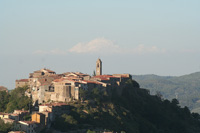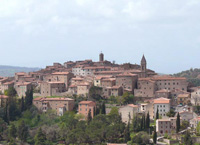 |
|
Castel del Piano [1] |
|
Castel del Piano
|
| Castel del Piano is one of the most important towns of Mount Amiata, and the visitor should seek out Palazzo Nericci, a museum dedicated to peasant culture, the Castiglionese Gate, Corso Nasini, the Monaci, Cantucci, Bruni, Alluigi and Cerboni Palaces, the Teatrino and the Loggia della Mercanzia. The name is derived by the Latin Castrum plani for its enviable position on the edge of a charming plateau surrounded by woods which cover the Monte Amiata; downhill the country opens on the valleys of the rivers Ombrone and Orcia degrading towards the Maremma. The history of Castel del Piano (current placename was already being used in 1198) was tied to the San Salvatore Abbey (the first documents date back to the IX and I centuries.) During the XIII century it fell under the rule of the Aldobrandeschi counts of Santa Fiora. During the XIV century, together with Arcidosso, it became part of the territory of the Siena Republic. During this period the "Statutes" were conceded (1393), the Fair showcasing merchandise and livestock, September 9th, 1402, and the first Palio historical horse races were run. The historical center was closed by boundary walls and it was accessed through two gates up till 1600: Pianese (today called Porta dell'orologio) and Castiglionese (today Porta Amiata). |
||||
| The medieval center maintains a harmonic series of parallel alleys interrupted by slopes, small squares (the evocative Piazzetta degli Ortaggi) and stairways. In 1600, Porta Spennazia was built to join the current corso Nasini, through a long stairway, (born by covering the moat which surrounded the walls) to the Piana (main road of the ancient village, where various artisan workshops were set up starting in the XVI century). The modern urban expansion, determined the Hei elopment of a structure based on a system of three avenues, characterized by an open plan and interrupted by gardens and squares which run along side the medieval center. The main squares of the town are: Piazza tonda or delle Storte, where the Palio of the contrade is held in september during celebrations to honor the Madonna delle Grazie, celebration which dates back to mid XVIII century lan ed on the Piazza del Campo di Siena model, and where a peperino obelisk dominates in the center and dates back to 1883 (the first in Italy to honor Garibaldi) and Piazza Madonna, delimited by the seventeenth century palazzo Cerboni, by the chiesa dell'Opera and by the oratory della Madonna delle Grazie. Palazzo Nerucci - Art Collection The building dates back to 1554 and it is completely restored in the last years. It has a colonnade with excellent frescoes. Today this palace is the cultural and artistic center of the town – the most important meeting and exhibitions are housed here. The Nasini family were painters originally from Castel del Piano who worked mainly on Mount Amiata, between the 1700s and the second half of the 1800s. They were very prolific artists and it can be said that there is no church, oratory or small chapel in this territory that does not have one of their paintings. [1] Palazzo Nerucci - Art Collection Palio delle Contrade Castel del Piano hosts one of the country's oldest horse-race events, dating back to the 15th century. The Palio delle Contrade is a three-day event accompanied by colourful festivities. The palio was raced for the first time in 1402. The city is divided into four contrade (quarters) which take part in the palio. On 6 September the horses are chosen and assigned to four participating and rival contrade (districts) and there's a street procession dedicated to the Madonna delle Grazie. On 8 September there's another street parade with music, followed by the blessing of the horses. The official horse race takes place at 6pm. |
| |||
The public swimming pool Campo di Sole in Castel del piano, (via dello Stadio), is within easy reach of Casa Santa Pia (18 km). |
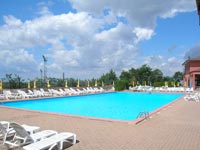 |
|||
The public swimming pool
|
||||
| Calici di Stelle a Castel del Piano |  |
|||
|
|
||||
 |
 |
 |
||
Chiesa della Madonna degli Schiavi
|
Castel del Piano |
Chiesa della Madonna degli Schiavi
|
||
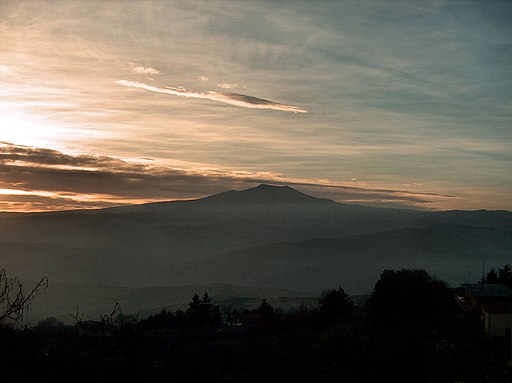 |
 |
 |
||
Monte Amiata
|
Castiglione d'Orcia |
Prato della Contessa |
||
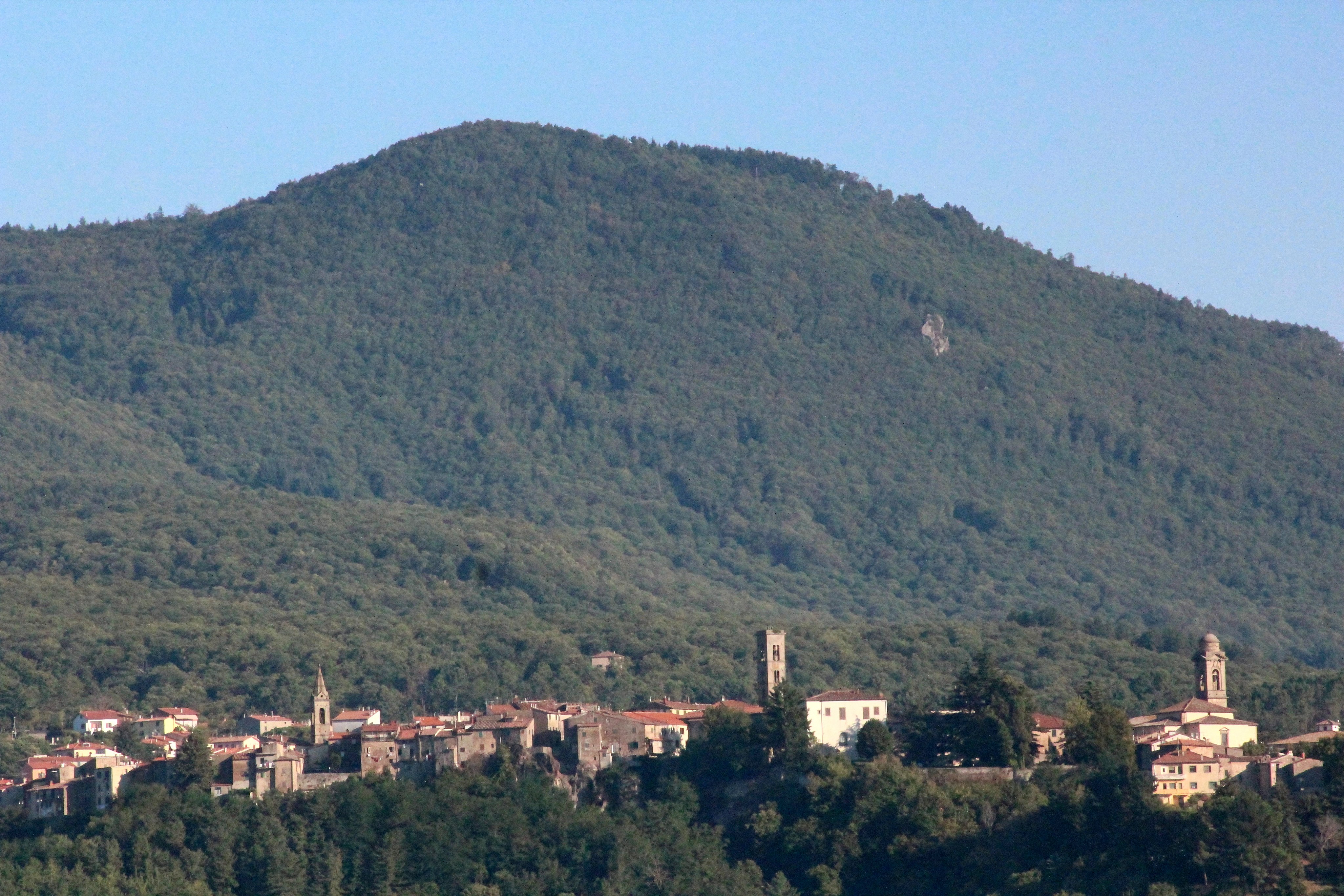 |
 |
 |
||
Panorama Castel del Piano
|
Castel del Piano, Chiesa di Santa Lucia |
Pieve dei Santi Stefano e Degna in Castiglione d’Orcia
|
||
Montenero and Montegiovi |
||||
Montegiovi, in the shadow of the village we can see the massive volume of HV PAVILLON, a realization of Gardini Gibertini Architetti [1]
|
||||
| Montenero and Montegiovi are two outlying wards of the Comune of Casteldelpiano built on the top of two hills. For lovers of winter sports, in few kms from the village there is the reascending installation from Prato delle Macinaie to the top of Monte Amiata with 15 kms of ski-slopes and ways for long-distance ski sunk in the centuries-old beech-wood. [read more] The town of Montenero d’Orcia is positioned half way between Mount Amiata and the upper Maremma region, on an isolated hillside 388 m (1.200 ft) above sea level. Since 1956, it is part of the municipality of Casteldelpiano. In the year 1000, the counts Aldobrandini of Santa Fiora had a castle built there to function as a sentinel over the river Orcia, owing to the threat of Siena’s increasing expansion. Still today, it is possible to admire the ancient castle-village with its gates (Porta Leone and Porta Medici), with its interesting piazzas: that of Poggio Valente where you can see the remains of the battlements of the old castle, and that of the well which was constructed by the Medici family. The Pieve di S. Lucia was built in the 12th century and was strongly modified in the 20th century. It houses well-restored 14th century part of the crucifix by Ambrogio Lorenzetti.
|
||||
Fungoamiata, on the east side of the main road between Castel del Piano and Seggiano, in a small town called Pian di Ballo which is not on most maps. There is only a small sign Fungoamiata is a small food production factory. Their products are sold all over Tuscany. The sales office is up the stairs on top of the factory. They have all their products on display (all in jars and preserved in olive oil): porcini and other types of mushrooms, artichokes, olives, asparagus, dried tomatoes.
Seggiano |
||||
| Segglano is situated 7 kms north of Castel del Piano. Among the most important monuments to see in Seggiano we point out here the Santuario della Madonna della Carità (Our Lady of the Charity Sanctuary), the Chiesa di San Rocco (Saint Rocco Church), the Parrocchiale di San Bartolomeo (Saint Bartolomeo Parish) and the Castello di Potentino (Potentino Castle). [read more]
|
||||
|
Galleria fotografica Monte Amiata
|
||||
Castel del Piano
|
||||
 |
 |
 |
||
Panorama of Castel del Piano
|
Castel del Piano |
Castel del Piano, Chiesa di San Biagio a Gravilona |
||
 |
 |
 Olivastra Seggianese |
||
Chiesa della Madonna degli Schiavi
|
Castel del Piano, Chiesa di Santa Lucia |
|||
|
||||
 |
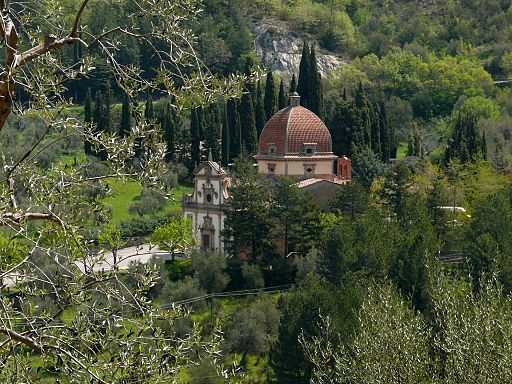 |
 |
||
Seggiano, visto dalla strada alla stazione di Monte Amiata |
Santuario della Madonna della Carità, Seggiano
|
Santuario della Madonna della Carità, Seggiano, facciata |
||
Trekking sul Monte Amiata | Sentieri per scoprire le meraviglie del Monte Amiata
|
|
Montegiovi, Montenero, Casidore, Collevergari, Leccio, Marrona, Piano di Ballo en Tepolini are frazioni of Castel del Piano.
|
|
|
|
Stroll around Montegiovi and the Potentino castle, Castel del Piano and Seggiano
|
|
| The Nasini family were painters originally from Castel del Piano who worked mainly on Mount Amiata, between the 1700s and the second half of the 1800s. They were very prolific artists and it can be said that there is no church, oratory or small chapel in this territory that does not have one of their paintings. The most important members of the family were the progenitor Francesco (1621-1695), his brother Antonio Annibale (1631-1668), his sons Antonio (1643-1715) and Giuseppe Nicola (1657-1736), and the son of the latter, Apollonio (1692-1768). They were the leading figures of devotional painting in the Maremman Baroque age. Among the many works of art preserved, of particular interest is (at Castel del Piano in the Church of the Opera) La Madonna col Bambino (Madonna with Child) by Giuseppe Nicola, perhaps the most talented member of the family. In this painting a strong narrative mood works well with the knowledgeable use of colour and design. The altarpiece of the Church of the Madonna of Grace, portraying La Madonna del Carmine (The Madonna of the Carmine) by the progenitor Francesco, is considered to be the artist’s principal work of art. Besides the works of art preserved in the towns of Mount Amiata, including those in the Church of the Capuchins at Arcidosso, of particular interest is the series of frescoes dedicated to St. Anthony of Padua in the Church of St. Francis in Grosseto, painted by Francesco and his son Antonio in 1679. |
|
| Semproniano, Church of Madonna delle Grazie |
|
| Outside the town of Semproniano stands the church of Madonna delle Grazie, founded in the sixteenth-century in a spot that had previously been occupied by a hermitage. The facade presents a simple portal with a lintel, flanked by small windows, and a rose. The inside, which has a rectangular lecture-hall layout, is decorated with interesting Baroque altars and houses a delightful fresco which is attributed to Francesco Nasini, and represents La Madonna col Bambino e sant’Antonio da Padova (Madonna and Child and St. Anthony of Padua). |
|
| Grosseto, Convent of St. Francis |
|
| The convent lies in the charming Piazza San Francesco. It is an unparalleled complex of great historic and artistic value, composed of convent rooms, the sacristy and the church. In addition to the numerous 14th and 15th century frescoes that decorate the church walls, it is possible to admire a cycle of Baroque painting by the Amiata painters Antonio and Francesco Nasini. These are located in the 18th century chapel dedicated to St. Anthony of Padua. The fresco of Transito di sant’Antonio stands out for its elegance of execution. |
|
| Typical Food Products
It’s not just wine, cheese and chestnuts from Monte Amiata, look out for porcini mushrooms, black truffles, wild herbs, cereals and honey, as well as fine meats. It seems the Cinta Senese pig is indigenous to the area and is still reared for fabulous hams, sausages and salami. Chianina and Maremmana cattle are also bred and the famous steaks find their way to the restaurant tables of Florence. A special mention must be made of the local sweets inspired by a unique combination of fruits, olive oil and chestnut flour from the mountain. Ask for the traditional cake ‘Poledina di Corsini’ or pick up a box of ‘Biscotto Salato di Vergari’, the biscuits once carried by the miners as lunch.
|
|
|
|
| C H E E S E P R O D U C E R S |
|
| Caseificio Ciolo località Cellane, 8 58033 Castel del Piano (GR) Tuscany / Maremma Italy +(0564)-956225 email e-mail this Sig. Andrea |
|
| W I N E R Y |
|
Azienda Agricola Montesalario Proprietor: Mario Pasqui Montecucco |
|
| A r c h i t e c t uR E |
|
HV PAVILLON (Gardini Gibertini Architetti) | www.archi-europe.com GGA architetcs is an Italian architectural practice based in Rimini working worldwide led by Alice Gardini and Nicola Gibertini. Imagery of HV Pavillon
|
|
| R E S T A U R A N T S |
|
Trattoria in Campagna Antica Fattoria Del Grottaione Ristorante Taverna Delle Logge Osteria della Bellamarsilia Antico Molino D'Orcia L'Olivastra Casa Corsini |
|
| P A S T R Y |
|
| Corsini Biscotti e Dolce Via Cellane, 9 - Tel. 0564/956787 Via Pozzo Stella, 43 58033 Castel del Piano (GR) +(0564)-955250 - 956044 http://www.corsinibiscotti.com/ Fungoamiata Loc. Pian di Ballo Castel del Piano (GR) tel 0564 956214 |
|
| F E S T I V A L |
|
| Amiata Piano Festival Via Pozzo Stella 14/a 58033 Castel del Piano (GR) +39-0564-973204 http://www.amiatapianofestival.it In July, August and September, concerts are held at the chamber music hall in Poggi del Sasso near Cinigiano at the foot of Monte Amiata, and other places (Sala Concerti Colle Massari, Podere San Giuseppe, Poggi del Sasso; Castello di Colle Massari, Poggi del Sasso; Cantina di Colle Massari, Poggi del Sasso and Castello di Porrona). |
|
| Festa of the Three Kings 58033 Castel del Piano (GR) In January
|
|
|
|



